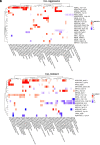Expression signature of human endogenous retroviruses in chronic lymphocytic leukemia
- PMID: 37871223
- PMCID: PMC10622969
- DOI: 10.1073/pnas.2307593120
Expression signature of human endogenous retroviruses in chronic lymphocytic leukemia
Abstract
Chronic lymphocytic leukemia (CLL) is one of the most diagnosed forms of leukemia worldwide and it is usually classified into two forms: indolent and aggressive. These two forms are characterized by distinct molecular features that drive different responses to treatment and clinical outcomes. In this context, a better understanding of the molecular landscape of the CLL forms may potentially lead to the development of new drugs or the identification of novel biomarkers. Human endogenous retroviruses (HERVs) are a class of transposable elements that have been associated with the development of different human cancers, including different forms of leukemias. However, no studies about HERVs in CLL have ever been reported so far. Here, we present the first locus-specific profiling of HERV expression in both the aggressive and indolent forms of CLL. Our analyses revealed several dysregulations in HERV expression occurring in CLL and some of them were specific for either the aggressive or indolent form of CLL. Such results were also validated by analyzing an external cohort of CLL patients and by RT-qPCR. Moreover, in silico analyses have shown relevant signaling pathways associated with them suggesting a potential involvement of the dysregulated HERVs in these pathways and consequently in CLL development.
Keywords: CLL; HERVs; RNA-Seq.
Conflict of interest statement
The authors declare no competing interest.
Figures







References
-
- Bullrich F., Croce C. M., Molecular biology of chronic lymphocytic leukemia. Basic and Clinical Oncology 2, 9–32 (2001).
-
- Cheson B. D., Chronic Lymphocytic Leukemia: Epidemiological, Familial, and Genetic Aspects. CLL 2, 1–30 (2001).
MeSH terms
Substances
Grants and funding
LinkOut - more resources
Full Text Sources
Molecular Biology Databases

